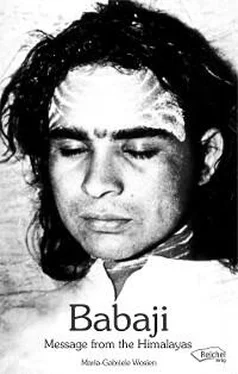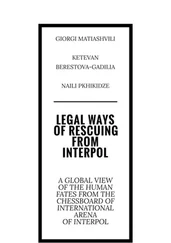Indian 'thinking' has moved towards introspection, the aim of which is not the theoretical and practical mastery of outer reality but rather the observation and analysis of those processes or practices that have resulted in direct religious experience - insight into the true source of life.
In this respect, Indian sages regard themselves as living laboratories where experimentation takes place, because only a metamorphosis of the inner consciousness in a human being can bring a lasting solution to one's problems. A transmutation occurs within whereby the gross physical elements undergo change: the spiritual or heavenly body is first conceived, gradually takes form and finally matures. These transformation processes are valued as service to matter, personified as the divine mother of the universe. For the rest of humanity these sages are examples of divinity incarnate, the most glorious achievement of human striving, as they mirror the perfection of the spirit dwelling inside the human body.
The highest state of being is beyond anything that may be associated with the world as we know it but, at the same time, the exact same spirit which is present in the sage is also inside every human being. Such a change of consciousness has this aim: while living in the world of illusion to remain uninvolved with any illusion or doubt and to abide in steady union with the inner divinity, and beyond that with universal transcendence. Having achieved this state of consciousness, a person accepts all and denies nothing, whether it be sublime or tragic, since everything is perceived as a form of divinity in manifestation.
Permeating the entire universe and existing in every created being, the divine essence of life remains anonymous, without countenance, veiled behind an infinite variety of masks. It can be experienced in the external world as well as being realized within.
The Upanishads and the Puranas state that a human being's yearning for the fulfilment of the deepest aspirations can only be realized with the help of a divine incarnation. The biography of such a one needs to be read as an embodiment and symbolic expression of divine laws.
3) THE AVATAR AS DIVINE INCARNATION
The phenomenon of avatars 3is fundamental to Hindu theology and plays a particularly important role when 'the end of the world' periodically recurs in the unfolding of the cycles.
Great avatars are extremely rare. They always appear during transition periods, during times of crisis in world history. Through decisive intervention they come to cure the body of the planet of a disease that threatens to disintegrate it. The advent of a redeemer in human form has often been compared to a swimmer who, to be able to rescue a drowning person, must plunge into the same sea.
The phenomenon of divinity descending from transcendence into manifestation is not a unique historical event; in fact, the recurring revelation of divine power is a central theme in the infinite drama of the evolutionary processes of the cosmos.
The appearance of an avatar has always given a profound impetus to world affairs and a new direction to the evolution of human consciousness. The teachings and significant events concerned with this personage have been recorded in the traditional scriptures, in the great epic poems, in the Puranas, Shastras and Upanishads and are often still alive, thousands of years later, in oral tradition.
Actually, the descent of divinities on earth is in a sense something quite ordinary and has been described in countless myths. The Bhagavad Gita gives perhaps the most succinct formulation of this phenomenon:
"Whenever spirituality decays and materialism is rampant, then, O Arjuna, I reincarnate Myself. To protect the virtuous, to destroy the evil-doers, and to establish righteousness, I am reborn from age to age." 4
Ramakrishna, the great saint of the nineteenth century, compares avatars with waves in the infinite divine ocean:
"Like a sea without confines, an infinite power dwells within spirit and matter. For a particular task, this infinite power assumes, so to speak, a concrete form during a given historical period - this is what we commonly call a great man. He is, strictly speaking, a local manifestation of the all-pervading power; in other words, a divine incarnation. His greatness is nothing but a manifestation of divine energy ..... the sea of life emerges at one place and is called Krishna, dives under again and appears in another place as Christ." 5
The coming of the avatar, the model of perfection in human form, the most exalted realization of divinity in human form, points the way in which human consciousness can evolve. For human beings, the presence of the avatar reveals the possibility of transcendence from terrestrial reality and moreover the possibility of establishing divine law, or that way of being, on earth.
The descent of God is thus closely linked with the rise of humanity. Hindu philosophy distinguishes these two aspects of divine birth:
"One is descent, the birth of the divine into human form or other form of nature - this is the eternal avatar: the other is ascent, the birth of a human into divinity - the human who rises up to the divine and becomes one with its consciousness, beyond the cycle of karmic rebirth." 6
The difference between the god in human form and the potentially divine human being is that the avatar is fully conscious of his identity with brahman, divine power. The human being, although created of the same substance, is blinded to perception of truth by the distracting senses of the body-mind. Yet, because the same immanent divine power is present in the body, it is this that enables the human to behold and discern the significance of an avatar, since only like can recognize like.
Although the avatar manifests in response to a deep-seated longing in humans for liberation and the fulfilment of their innermost desires, the fact is, his true significance is comprehended by only a few. The life of Christ was an example of this: most of his contemporaries considered him to be merely the son of a carpenter from Nazareth and the orthodox Jewish clergy deemed him an undesirable element jeopardising their hierarchical positions and privileges of power. Krishna; as another example, was raised in a family of princes but his divine power was revealed only to a scant few of his contemporaries.
Adi Shankara 7, perhaps the most outstanding teacher of Vedanta, has commented extensively on the phenomenon of the avatar:
"The ignorant think that I have just now come into manifestation, having been unmanifest hitherto, though I am the ever-luminous Lord, I am not manifest to all people, that is to say, I am manifest to only a few who are my devotees; for I am veiled by yoga-maya." 8
Traditional religious scriptures everywhere emphasise that it is ignorance of the divinity dwelling within that keeps a human blindfolded.
On rare occasions, the avatar reveals himself as Ishwara, the Lord of Creation. In this form, he dissolves the limitations of the human condition and to the faithful he grants spiritual vision. When the Lord transfigures himself before the eyes of his disciple, this is tantamount to an enlightenment experience for that disciple, whose inner eye perceives the unlimited consciousness of the divine in its transcendent form:
"Six days later Jesus took Peter and James and John, the brother of James, and led them up a high mountain where they were alone, and in their presence he was transfigured, his face shone like the sun and his clothes became as white as light." 9
"And when he was hung up upon the Cross on Friday, at the sixth hour of the day, darkness came upon all the earth. And my Lord standing in the midst of the cave and filling it with light said: 'John, unto the multitude below in Jerusalem I am being crucified and pierced with lances and reeds and given vinegar and gall to drink. But to you I am speaking, and listen to what I speak. I put into your mind to come up to this mountain, so that you may hear what a disciple should learn from his teacher and a man from God.'"
Читать дальше










